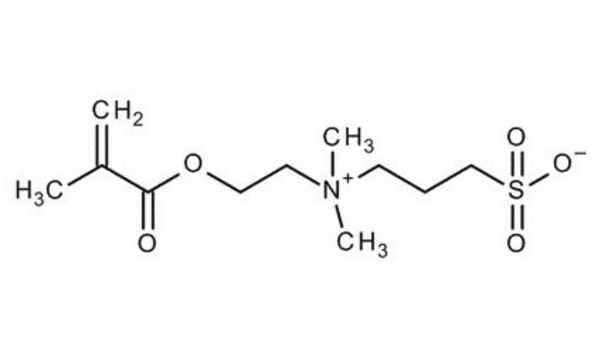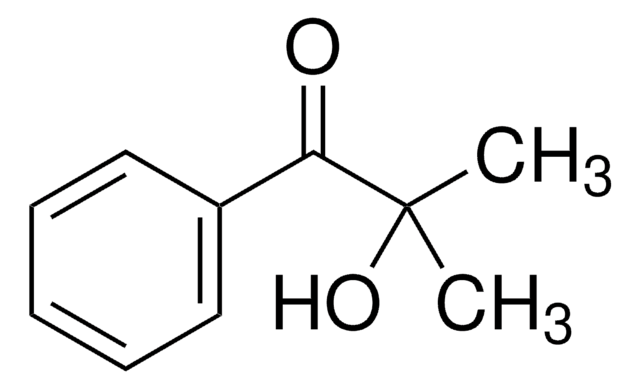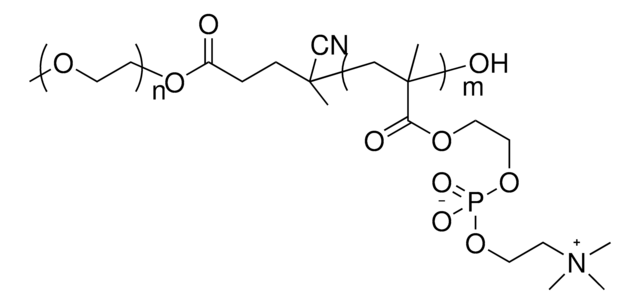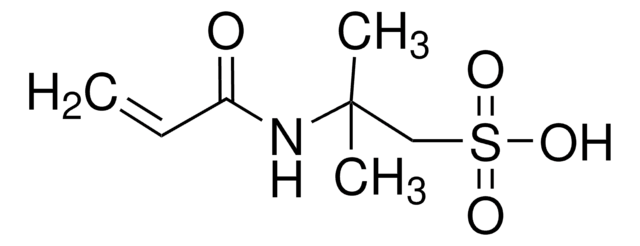Wszystkie zdjęcia(1)
Kluczowe dokumenty
925640
Poly (ethylene glycol)-block-Poly (sulfobetaine methacrylate)
PEG average Mn 5000, PSBMA Mn 13,000
Synonim(y):
PEG-PDMAPS, PEG-PSBMA, PSBMA, Poli (metakrylan sulfobetainy)
Zaloguj sięWyświetlanie cen organizacyjnych i kontraktowych
Wybierz wielkość
Wybierz wielkość
Zmień widok
About This Item
Wzór liniowy:
CH3(C2H4O)nC6H7O2N(C11H21O5NS)mOH
Kod UNSPSC:
12352112
NACRES:
NA.23
Polecane produkty
masa cząsteczkowa
PEG average Mn 5000
PSBMA Mn 13,000
Poziom jakości
Powiązane kategorie
Zastosowanie
Biokompatybilny, nieporostowy kopolimer blokowy składający się z neutralnego bloku PEG i zwitterionowego bloku poli(metakrylanu sulfobetainy) (PSBMA).
Poli(metakrylan sulfobetainy) (PSBMA) jest dobrze znanym zwitterionowym polimerem, nietoksycznym i biokompatybilnym. Każda z jego powtarzających się jednostek zawiera zarówno ładunek dodatni, jak i ujemny, co prowadzi do jego silnej zdolności hydratacji.
Powierzchnie pokryte PSBMA wykazały właściwości superhydrofilowe i silną odporność na adsorpcję białek / adhezję bakterii, co czyni ten polimer obiecującym materiałem w zastosowaniach przeciwporostowych.
Poli(metakrylan sulfobetainy) (PSBMA) jest dobrze znanym zwitterionowym polimerem, nietoksycznym i biokompatybilnym. Każda z jego powtarzających się jednostek zawiera zarówno ładunek dodatni, jak i ujemny, co prowadzi do jego silnej zdolności hydratacji.
Powierzchnie pokryte PSBMA wykazały właściwości superhydrofilowe i silną odporność na adsorpcję białek / adhezję bakterii, co czyni ten polimer obiecującym materiałem w zastosowaniach przeciwporostowych.
Ta strona może zawierać tekst przetłumaczony maszynowo.
Kod klasy składowania
11 - Combustible Solids
Klasa zagrożenia wodnego (WGK)
WGK 3
Temperatura zapłonu (°F)
Not applicable
Temperatura zapłonu (°C)
Not applicable
Wybierz jedną z najnowszych wersji:
Certyfikaty analizy (CoA)
Lot/Batch Number
It looks like we've run into a problem, but you can still download Certificates of Analysis from our Dokumenty section.
Proszę o kontakt, jeśli potrzebna jest pomoc Obsługa Klienta
Masz już ten produkt?
Dokumenty związane z niedawno zakupionymi produktami zostały zamieszczone w Bibliotece dokumentów.
Jiang Wu et al.
Acta biomaterialia, 40, 172-181 (2016-05-05)
Nonfouling materials such as neutral poly(ethylene glycol) (PEG) and zwitterionic poly(sulfobetaine methacrylate) (pSBMA) are ideal biocompatible materials for drug, especially protein drug delivery. The interaction behavior of protein between the nonfouling materials could cause great impact on their future applications
Se Yeong Lee et al.
Biomaterials research, 22, 3-3 (2018-02-17)
Zwitterionic molecules have been widely studied as coating materials for preparing anti-fouling surfaces because they possess strong hydration properties that can resist non-specific protein adsorption. Numerous studies on surface modification using zwitterionic molecules have been investigated, such as electrochemically mediated
Nasz zespół naukowców ma doświadczenie we wszystkich obszarach badań, w tym w naukach przyrodniczych, materiałoznawstwie, syntezie chemicznej, chromatografii, analityce i wielu innych dziedzinach.
Skontaktuj się z zespołem ds. pomocy technicznej![[2-(Methacryloyloxy)ethyl]dimethyl-(3-sulfopropyl)ammonium hydroxide 95%](/deepweb/assets/sigmaaldrich/product/structures/217/219/73c91e1c-0ee4-4b3d-bead-a6dc3d09d1da/640/73c91e1c-0ee4-4b3d-bead-a6dc3d09d1da.png)








